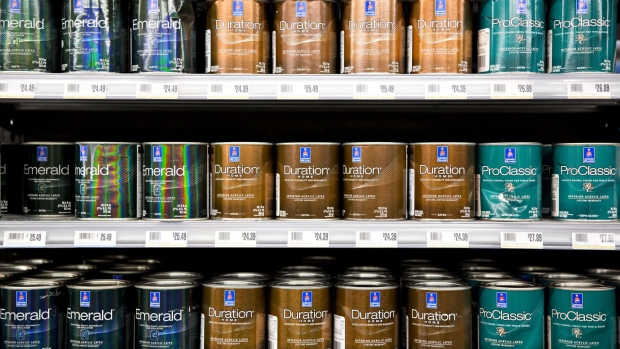Jan 26, 2023
Sherwin-Williams Sees ‘Very Challenging’ 2023 as Housing Market Slows
, Bloomberg News

(Bloomberg) -- Sherwin-Williams Co. slumped after it provided earnings guidance that fell short of analyst expectations, underscoring macro pressures from a slowing US housing market and inflation.
As it rang the alarm bells on supply-chain disruptions and omicron-induced cost surges in the past two years, the top US paintmaker is among the first firms to detail how a cooling housing market can impact corporate earnings. Existing home sales, which drive a portion of its paints and coatings business, have declined year-over-over for 16 straight months while elevated mortgage rates and falling single-family starts and permits mean its new residential volume could decline 10%-20% this year. At the same time, inflation will weigh on consumers’ “DIY” behavior in the US and Europe and an uncertain Covid recovery in China will also hurt industrial sales.
“We will not be immune from what we expect to be a very challenging demand environment in 2023,” Chief Executive Officer John G. Morikis said in a statement. “Visibility beyond our first half of the year is limited.”
Specifically, Morikis expects sales and earnings to be “significantly better” in the first half than the second half, citing benefits carried over from the price increases and cost cuts introduced last year and “very meaningful deceleration of demand” in new residential sales in the back half of the year. That said, he expects to fine-tune guidance for second-half outlook in their second-quarter earnings conference call.
“Our base case in 2023 remains to prepare for the worst based on current indicators. We believe this is the most realistic outlook at this time,” he said during the earnings call on Thursday.
The shares fell as much as 11.3% in New York trading Thursday — the most since it cut its outlook in late July during the release of the company’s second-quarter results. The company’s peer, PPG Industries, missed first-quarter forecast expectations last week as it warned of economic uncertainty in Europe and China.
The company is focusing on investing, adding stores and growing the market share of its residential repaint business — its largest and fastest growing segment, which includes paints and coatings for inside and outside the home — saying that factors such as home-price appreciation and aging housing stock can help offset the impact from slowing existing home sales.
The paints and coatings company expects adjusted earnings per share for the year of $7.95 to $8.65, well below the average analyst estimate compiled by Bloomberg of $10.18. It also anticipates full-year sales growth to be flat or down a mid-single digit percentage compared to a year ago. While raw material costs are expected to fall, other costs including wages are likely to climb.
The guidance is “reflective of that challenging backdrop that the data has been portending and the company has wisely reset expectations lower this year,” said Sean Gilmartin, a chemicals equity research analyst at Bloomberg Intelligence, noting that the company has been traditionally conservative in its forecast.
The firm expects to maintain majority of its prices in the year as it sees continued sequential decreases in raw-material costs and progress in targeted cost cuts. This is a departure from margin contraction seen last year, which prompted it to raise prices by 10% in September. It plans to recommend an annual dividend increase of 0.8%, to $2.42 per share, at its board meeting next month and expects to continue making “opportunistic” share repurchases.
(Updates share price, adds CEO commentary in fifth paragraph.)
©2023 Bloomberg L.P.





